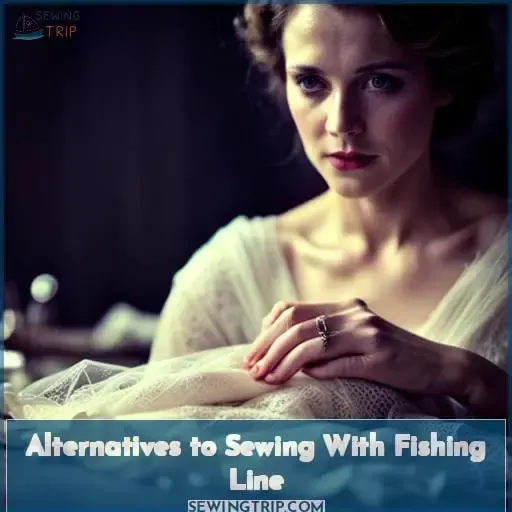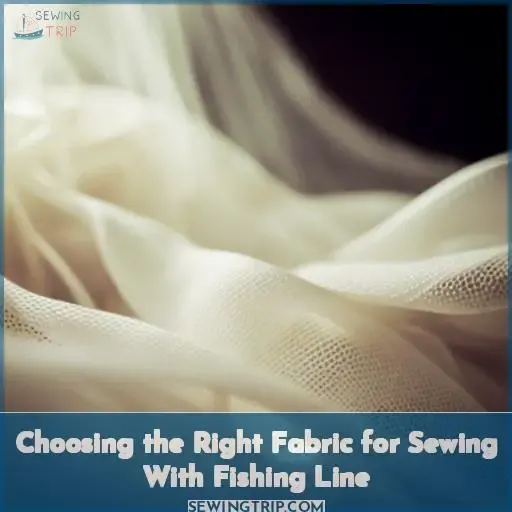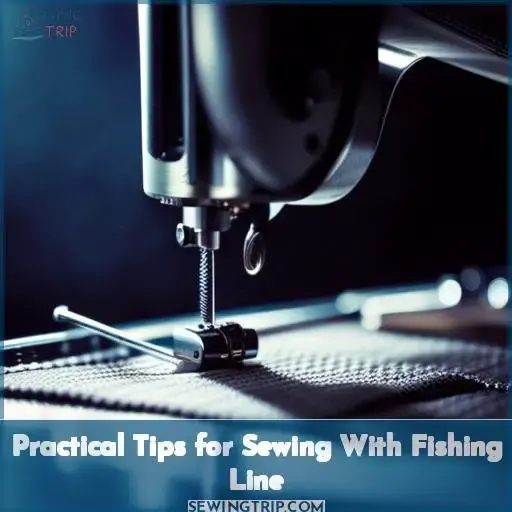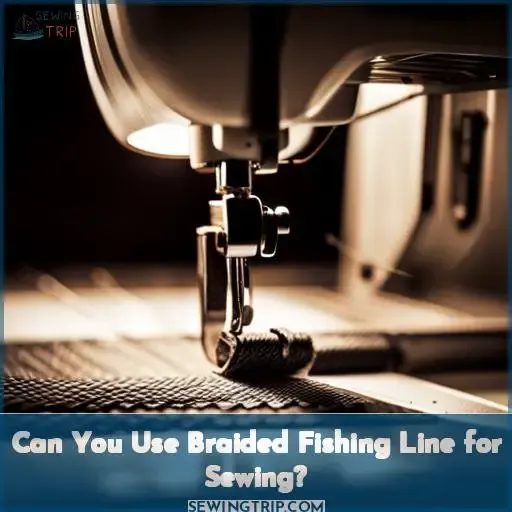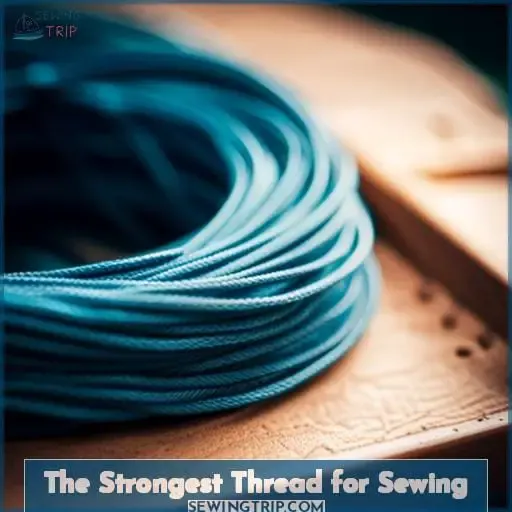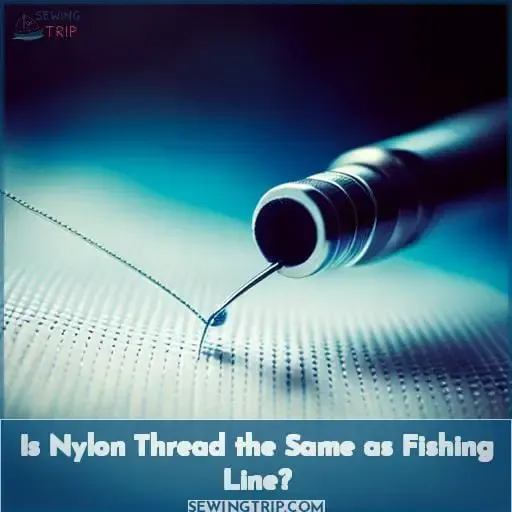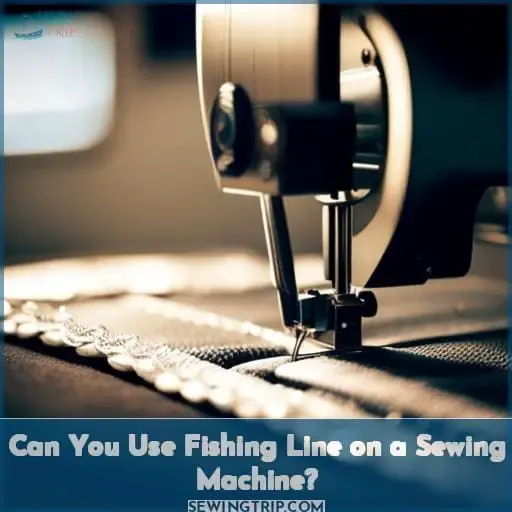This site is supported by our readers. We may earn a commission, at no cost to you, if you purchase through links.
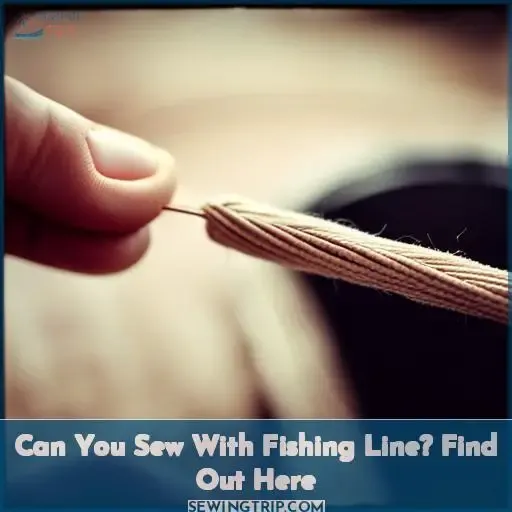 Imagine the thrill of sewing with a material that can withstand any challenge, providing strength and durability to your creations.
Imagine the thrill of sewing with a material that can withstand any challenge, providing strength and durability to your creations.
In this article, we will explore the possibilities and intricacies of using fishing line as a substitute for traditional thread. Discover its suitability for different projects, cost-effectiveness compared to regular thread, and tips for successful sewing.
Table Of Contents
- Key Takeaways
- Can You Use Fishing Line for Sewing?
- Alternatives to Sewing With Fishing Line
- Choosing the Right Fabric for Sewing With Fishing Line
- Practical Tips for Sewing With Fishing Line
- Can You Use Braided Fishing Line for Sewing?
- Dental Floss as an Alternative for Sewing
- The Strongest Thread for Sewing
- Is Nylon Thread the Same as Fishing Line?
- Can You Use Fishing Line on a Sewing Machine?
- Frequently Asked Questions (FAQs)
- Conclusion
Key Takeaways
- Fishing line is a strong and suitable option for heavy-duty sewing projects.
- It is cost-effective compared to traditional nylon threads, saving money in the long run.
- Needle selection and matching thread weight are crucial for successful sewing with fishing line.
- Nylon fabric is recommended for sewing with fishing line due to its strength and versatility.
Can You Use Fishing Line for Sewing?
So you’re wondering if fishing line can be used for sewing? Well, let’s discuss the points.
First, fishing line is known for its strength and lightweight properties which make it suitable for various sewing projects.
Second, using fishing line as a substitute for traditional thread can be cost-effective since expensive thread isn’t necessary.
Lastly, when using fishing line for sewing, it’s important to choose the appropriate needle size and match the weight of your fabric with the right thread to ensure successful results.
Strength and Suitability for Sewing Projects
Yes, you can sew with fishing line for various projects that require strength and durability.
-
Fishing Line Strength:
- Fishing lines are designed specifically with high tensile strength in mind.
- They provide exceptional resistance against tearing or breaking during use.
- This makes them suitable for heavy-duty applications such as backpacks or vests.
-
Cost-effectiveness:
- Expensive thread options may not always be necessary when using fishing lines.
- The affordability of these lines allows them to be an economical choice without compromising on quality or performance.
-
Needle Selection and Matching Thread Weight:
- When sewing with fishing lines, it’s crucial to choose appropriate needle sizes based on your fabric type.
- For lightweight fabrics like silk or chiffon, use smaller needles (such as size 9).
- For heavier fabrics like denim or canvas, opt for larger needles (size 16).
Matching thread weight means selecting a thickness similar to what traditional threads would offer:
- Light-weight nylon threads should correspondingly match lighter-weight fabrics
- While thicker ones suit sturdier materials more effectively.
Keep these factors in mind while embarking on any project involving sewing machine compatibility!
Cost-effectiveness Compared to Traditional Thread
Using fishing line for sewing can be a cost-effective alternative to traditional thread.
When comparing the cost of fishing line and nylon thread, you’ll find that fishing line is often more affordable.
However, it’s important to consider other factors such as strength comparison, needle selection, and fabric suitability before making your choice.
| Category | Cost-effectiveness |
|---|---|
| Fishing Line | Affordable |
| Nylon Thread | Can be expensive |
When it comes to cost-effectiveness in sewing projects, using fishing line can save you money compared to traditional nylon threads. Fishing lines are generally more affordable than nylon threads available in craft stores.
However, keep in mind that while the upfront costs may be lower with fishing lines when considering long-term use or specific projects requiring specialized threading techniques like embroidery or quilting – choosing quality nylon threads might give better results.
Needle Selection and Matching Thread Weight
When sewing with fishing line, it’s important to carefully select the appropriate needle size and match the thread weight to ensure successful stitching.
Here are some tips for needle selection and matching thread weight when using fishing line:
- Choose a sewing needle specifically designed for use with fishing line.
- Opt for a heavy-duty or upholstery needle that can handle the strength of the fishing line.
- Consider using a larger-sized needle to accommodate the thickness of the fishing line.
- Match your thread weight to your fabric type – heavier fabrics may require thicker threads while lighter fabrics may need thinner ones.
Alternatives to Sewing With Fishing Line
Looking for unique stitching styles or techniques beyond fishing line?
Consider using different materials like a knitting needle or freehand drawing to achieve the desired effect.
Another alternative is utilizing dual thread usage, where you use two types of thread for outlining and filling in a design, providing added strength to your project.
If you enjoy intricate patterns, cross stitching with fishing line or cross stitch gridding can be excellent choices that offer beautiful and detailed results.
Unique Stitching Styles Using Different Materials
Try exploring unique stitching styles by using different materials as alternatives to sewing with fishing line.
Get creative and experiment with unconventional styles, such as the lettuce hem technique or incorporating other strong threads for artistic sewing.
Exploring Techniques Beyond Fishing Line
If you’re looking to expand your stitching repertoire, there are plenty of alternatives to sewing with fishing line that you can explore.
- Freehand Drawing: Use your creativity and draw directly on the fabric for a personalized touch.
- Dual Thread Usage: Experiment with using two types of thread for added texture and visual interest.
- Creative Embellishments: Explore different ways to embellish your projects, such as adding beads, sequins, or embroidery stitches for a decorative touch.
Dual Thread Usage for Added Strength
Consider using a second thread alongside your regular sewing thread for added strength and durability in your projects.
Here is a comparison of different thread alternatives and their benefits:
| Thread Alternatives | Strength Comparison | Dual Thread Benefits |
|---|---|---|
| Braided Fishing Line for Sewing | Strong, but may tear fabric | Provides extra reinforcement |
| Dental Floss | Suitable for certain fabrics like leather | Easy to use, no need to double or tie down |
| Nylon Thread | The strongest option | High tensile strength for increased durability |
Using dual threads can be an alternative stitching technique that adds stability to your sewing projects.
Cross Stitching and Cross Stitch Gridding Options
You can achieve intricate patterns and designs by cross stitching with fishing line, offering a unique alternative to sewing with traditional thread. Explore creative alternatives like cross stitch gridding for custom patterns that challenge the limitations of fishing line.
Choosing the Right Fabric for Sewing With Fishing Line
When it comes to sewing with fishing line, choosing the right fabric is crucial for achieving successful results.
Nylon fabric is highly recommended due to its strength and flexibility, making it an ideal choice for working with fishing line.
Not only does nylon come in various sizes and shapes, but it also offers durability for long-lasting projects such as fishing nets or lures.
Suitability of Nylon Fabric for Fishing Line Sewing
To ensure successful sewing with fishing line, consider the suitability of nylon fabric.
Nylon is known for its strength and flexibility, making it ideal for various sewing projects.
- Strength and flexibility
- Durability
- Variety of options available
- Suitable for various sewing projects
- Ideal fabric choice when working with fishing line
Variety of Nylon Fabric Options Available
When choosing fabric for sewing with fishing line, explore the variety of nylon fabric options available to find the perfect match for your project. Consider factors such as strength, flexibility, and durability when selecting your nylon fabric.
| Nylon Fabric Options | Sewing Techniques |
|---|---|
| Ripstop Nylon | Ideal for lightweight garments or outdoor gear due to its tear-resistant properties. |
| Cordura Nylon | Known for its exceptional abrasion resistance and used in heavy-duty applications like backpacks or luggage. |
Multiple Applications of Nylon Fabric
Nylon fabric offers a wide range of applications when it comes to sewing with fishing line. Its versatility and strength make it perfect for creating custom designs, such as fishing nets, lures, and baits.
Nylon fabric ensures durable sewing projects that can withstand the test of time.
Durability of Nylon Fabric
When choosing the right fabric for sewing with fishing line, consider nylon fabric’s durability.
Nylon is strong and flexible, making it suitable for various sewing techniques.
It offers an alternative to traditional thread while providing the necessary strength to overcome fishing line limitations.
Practical Tips for Sewing With Fishing Line
When sewing with fishing line, it’s important to consider the time required for your projects, as this will depend on the number of layers in your design.
Additionally, selecting the right needle is crucial – choose stainless steel needles (size 20 or 30) and sharpen them before use for easier sewing. Remember to avoid pushing too hard when inserting the needle through fabric to prevent damage.
Finally, keep in mind that fishing line isn’t elastic and comes in various diameters suitable for different project sizes.
Time Considerations for Fishing Line Projects
If you’re considering sewing with fishing line, it’s important to take into account the time considerations for completing your projects.
- Project planning
- Stitching techniques
- Fabric selection
Needle Selection and Sharpening for Easier Sewing
To ensure smooth and effortless sewing with fishing line, prioritize proper needle selection and sharpening.
Choose stainless steel needles (size 20 or 30) for sewing with fishing line, and sharpen them before use for easier sewing.
| Needle Selection and Sharpening | Practical Tips |
|---|---|
| – Choose stainless steel needles | – Prioritize proper needle selection |
| (size 20 or 30) | – Sharpen the needles before use |
Proper Needle Usage to Avoid Fabric Damage
To avoid damaging the fabric, use a sharp needle and handle it carefully when sewing with fishing line.
Ensure needle safety by avoiding excessive force while inserting the needle through the fabric.
Take precautions to preserve fabric compatibility and employ proper sewing techniques for successful projects.
Understanding Fishing Line Properties
To sew with fishing line effectively, understand its properties and how they impact your projects. Consider needle selection, fabric choices, and thread alternatives to achieve the best results in your sewing techniques.
- Fishing line is strong and durable, making it ideal for projects that require a lot of strength.
- Fishing line is thin and flexible, making it easy to maneuver around curves and tight spaces.
- Fishing line is waterproof, making it ideal for projects that will be exposed to water.
- Fishing line is not as elastic as thread, so it is important to choose the right needle size and fabric for your project.
- Fishing line can be difficult to see, so it is important to use a contrasting thread or fabric for your project.
- Fishing line is not as forgiving as thread, so it is important to be careful when sewing with it.
- Fishing line can be used as a substitute for thread in a variety of sewing projects.
Can You Use Braided Fishing Line for Sewing?
Can you use braided fishing line for sewing?
Braided fishing line is strong and flexible, making it suitable for certain sewing projects. However, there’s a risk of fabric tearing instead of creating a secure seam when using braided fishing line.
It’s important to note that while it can be used as a temporary solution, replacing it with regular thread is recommended for long-term durability.
Consider using braided fishing line for creating curly hems or ruffles in your sewing projects.
Strength and Flexibility of Braided Fishing Line
Yes, you can use braided fishing line for sewing, but it’s important to consider its strength and flexibility.
- Braided Line Strength: Braided fishing line is known for its strong and durable qualities.
- Fishing Line Alternatives: While braided fishing line can be used, there are other alternatives like dental floss or nylon thread that may be more suitable for certain projects.
- Sewing Machine Compatibility: It’s essential to check if your sewing machine is compatible with using braided fishing line before attempting any sewing projects with it.
Potential Fabric Tearing With Braided Fishing Line
Using braided fishing line for sewing can result in fabric tearing instead of a secure seam.
The strong and rigid nature of the braided line can cause it to cut through the fabric, leading to challenges in achieving a durable and reliable stitch.
Temporary Vs. Long-term Sewing Solution
If you’re looking for a temporary sewing solution, braided fishing line can be used in a pinch. However, it’s not ideal for long-term use as it’s stronger than fabric and can lead to fabric tearing.
- Fishing line durability
- Fabric tearing risks
- Strength comparison
- Long-term vs. Temporary solution
- Alternative materials
Specific Uses for Braided Fishing Line in Sewing
Braided fishing line can be utilized for specific sewing applications, providing strength and flexibility in various projects. It’s beneficial for creating curly hems or ruffles, making it a great alternative sewing material.
Dental Floss as an Alternative for Sewing
Did you know that dental floss can be used as an alternative for sewing? It’s true! Dental floss is suitable for sewing fabrics like leather and canvas.
All you need is waxed dental floss and a sewing needle, making it a convenient option for quick repairs or small projects.
Just remember to take caution when melting the floss to secure your stitches, ensuring not to burn the fabric in the process.
Suitability for Sewing Fabrics Like Leather and Canvas
For sewing fabrics like leather and canvas, dental floss can be a suitable alternative. It provides the strength needed to withstand the demands of these materials. Plus, it offers cost-effectiveness in comparison to traditional thread options.
Just make sure to choose the appropriate needle size and match the thread weight for optimal results.
Method of Using Waxed Dental Floss for Sewing
Try using waxed dental floss as an alternative for sewing by threading the needle and stitching through fabrics like leather and canvas.
- Thread the needle with waxed dental floss.
- Stitch through the fabric, creating your desired design.
- After stitching, leave half an inch of floss out and use a lighter to carefully melt it, securing your stitches while being cautious not to burn the fabric.
Sewing with waxed dental floss is a creative way to explore alternative materials for your sewing projects. It can be particularly useful when working with fabrics like leather or canvas that require strong stitches for durability.
By following this simple method of using waxed dental floss as thread, you can achieve reliable results without having to rely on traditional sewing threads.
However, it’s important to exercise caution when melting the ends of the dental floss after stitching. The heat from a lighter or flame may cause damage or discoloration if held too close or applied for too long on delicate fabrics such as silk or synthetics.
Remember these key points:
- Use only waxed dental floss specifically designed for sewing purposes.
- Threading is straightforward; simply pass one end of the threaded needle through each stitch until completed.
- Before melting excess thread at both ends near finished seams (if desired), ensure no flammable objects are nearby in case sparks occur during heating process
Cautionary Measures When Melting the Floss
When melting the floss, be cautious not to burn the fabric.
Ensure sewing durability by selecting appropriate needle size and considering fabric compatibility.
Remember that dental floss is just one of many fishing line alternatives available for your sewing projects.
The Strongest Thread for Sewing
When it comes to finding the strongest thread for sewing, nylon thread is your best bet.
Nylon thread is known for its exceptional strength and durability, making it ideal for a wide range of sewing projects.
If you’re looking to invest in high-quality nylon thread, Singer Nylon Thread is highly recommended for its superior strength and reliability.
Advantages of Nylon Thread in Terms of Strength
If you want the strongest thread for your sewing projects, look no further than nylon thread.
Nylon thread offers superior strength and durability compared to other threads.
It’s perfect for applications where fishing line falls short, such as sewing delicate fabrics or using a sewing machine.
Considerations for Durability of Cotton Threads
Ensure the durability of your sewing projects by considering the strength and longevity of cotton threads, known to be one of the strongest options for sewing.
Cotton thread is durable, but it may not be suitable for all fabrics. Be cautious with fabric tearing concerns and consider alternatives like strong nylon thread or dental floss for added strength.
Additionally, check compatibility with your sewing machine before starting your project.
Recommended Brand for Strong Nylon Thread
To ensure the strength and durability of your sewing projects, it’s recommended to use Singer Nylon Thread, a highly regarded brand known for its strong molecular bonds and quality construction.
- Strong molecular bonds for added strength
- Quality construction ensures durability
- Suitable for various sewing projects
- Compatible with both hand sewing and machine stitching
- Available in a wide range of colors
Is Nylon Thread the Same as Fishing Line?
Now let’s address the question of whether nylon thread is the same as fishing line.
While both materials can contain nylon, they aren’t interchangeable in sewing projects.
Nylon thread is typically thicker than fishing line and designed for use with fabric, offering strength and durability.
On the other hand, fishing lines vary in thickness and are made specifically for their high tensile strength to withstand heavy weights when angling.
So while they may share some similarities, it’s important to choose the right material based on your specific sewing needs or outdoor activities.
Different Materials Used in Fishing Lines
Different materials are used in fishing lines, so it’s important to understand that nylon thread isn’t the same as fishing line.
When sewing, consider alternatives like braided fishing line or dental floss for specific purposes.
Choose fabric options that work well with fishing line and follow practical tips for successful sewing projects.
Comparing Thickness and Strength of Nylon Thread and Fishing Line
When comparing the thickness and strength of nylon thread and fishing line, it’s important to note that nylon thread is usually thicker than fishing line.
Nylon thread is known for its durability and versatility, making it compatible with sewing machines.
Consider using nylon thread for recommended sewing projects instead.
Distinct Purposes and Applications of Each
While fishing line and nylon thread may share some similarities, they have distinct purposes and applications.
Nylon thread is known for its strength, making it suitable for various sewing techniques.
Fishing line, on the other hand, is designed specifically for fishing but can be used in unique stitching styles and certain fabric projects.
Proper needle selection and considering fabric suitability are crucial when using either material.
Can You Use Fishing Line on a Sewing Machine?
So, you’re wondering if you can use fishing line on a sewing machine.
Well, the answer is yes, but with some caveats.
While fishing line can be used on a sewing machine for certain projects like upholstery or heavy-duty items, it’s important to note that it may not work well with lighter fabrics and delicate stitches.
Additionally, using fishing line on your sewing machine could potentially cause damage or breakage if not handled carefully.
Compatibility and Limitations of Fishing Line on Sewing Machines
If you’re wondering whether fishing line can be used on a sewing machine, the answer is yes, but there are some compatibility and limitations to consider.
Sewing machines can handle fishing line, but it’s important to note that not all machines are compatible.
Some risks and issues include potential tangling or breaking of the thread due to its stiffness and lack of elasticity.
It’s crucial to adjust your sewing techniques accordingly when using fishing line on a sewing machine.
Potential Issues and Risks of Using Fishing Line on a Machine
Using fishing line on a sewing machine can pose potential issues and risks.
Machine challenges may arise due to the unique properties of fishing line, such as its strength and lack of elasticity.
Thread breakage is more likely with fishing line, requiring frequent stops for rethreading.
Fabric tension can be difficult to maintain while using fishing line, leading to uneven stitches or fabric distortion.
Proper needle selection is crucial to avoid damaging the fabric or causing thread jams.
Ensuring stitch quality may require adjustments in machine settings and techniques when working with fishing line.
Frequently Asked Questions (FAQs)
Is fishing line suitable for sewing delicate fabrics like silk or chiffon?
Yes, fishing line can be used for sewing delicate fabrics like silk or chiffon.
It’s important to choose a thin and lightweight fishing line to avoid damaging the fabric.
Experiment with different needle sizes and techniques for best results.
Happy sewing!
Can fishing line be used for machine embroidery?
Absolutely! Fishing line is the ultimate power tool in your sewing arsenal. With its strength and tenacity, it will conquer any fabric with ease.
What are some alternatives to fishing line for sewing projects?
Looking for alternatives to fishing line for your sewing projects?
Consider dental floss, braided fishing line, or nylon thread.
These options provide strength and flexibility while allowing you to unleash your creativity and achieve mastery in your sewing endeavors.
Can fishing line be used for sewing heavy-duty items like leather jackets or denim jeans?
Yes, fishing line can be used for heavy-duty items like leather jackets or denim jeans. Its strength and durability make it suitable for sewing projects that require extra reinforcement.
Is fishing line recommended for sewing projects that require stretch or elasticity, like activewear or swimwear?
For sewing projects that require stretch and elasticity, like activewear or swimwear, fishing line may not be the best choice. Consider using specialized elastic thread to ensure optimal functionality and comfort in your garments.
Conclusion
To conclude, sewing with fishing line opens up a world of possibilities for creative and durable projects.
The strength and suitability of fishing line make it a viable alternative to traditional thread, especially for projects that require extra durability.
However, it’s important to consider the fabric and needle selection when sewing with fishing line.
Additionally, exploring alternatives like braided fishing line and dental floss can offer unique stitching options.
Overall, fishing line can be a valuable tool in your sewing arsenal, adding strength and durability to your creations.

